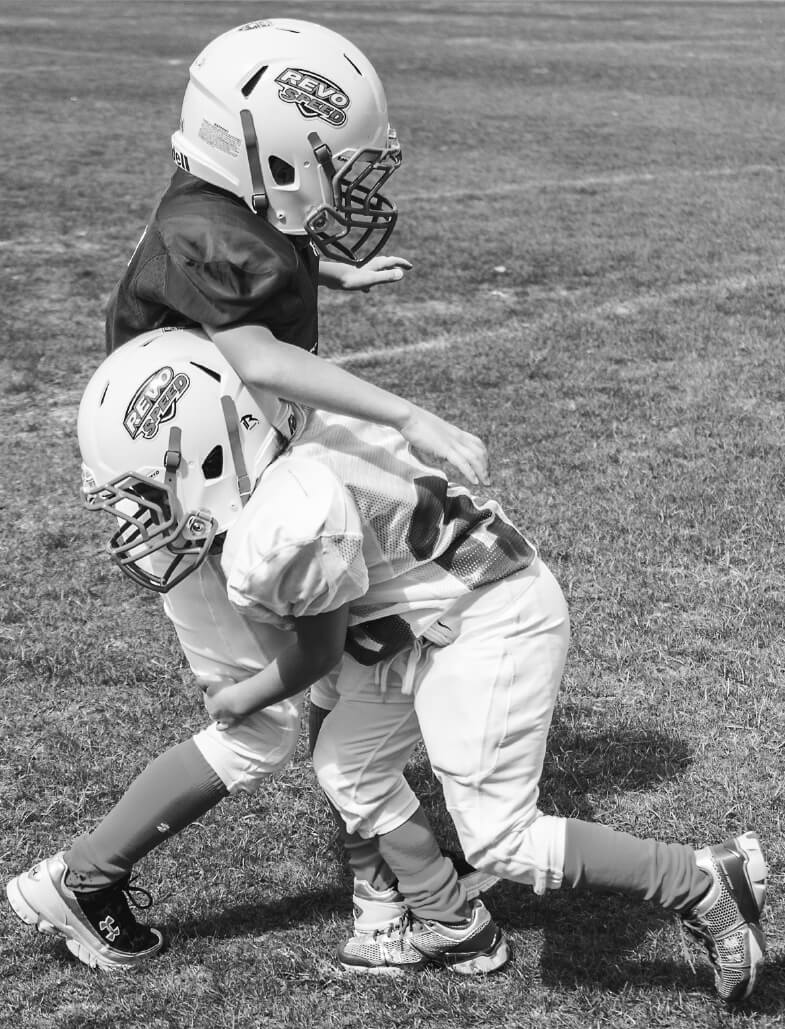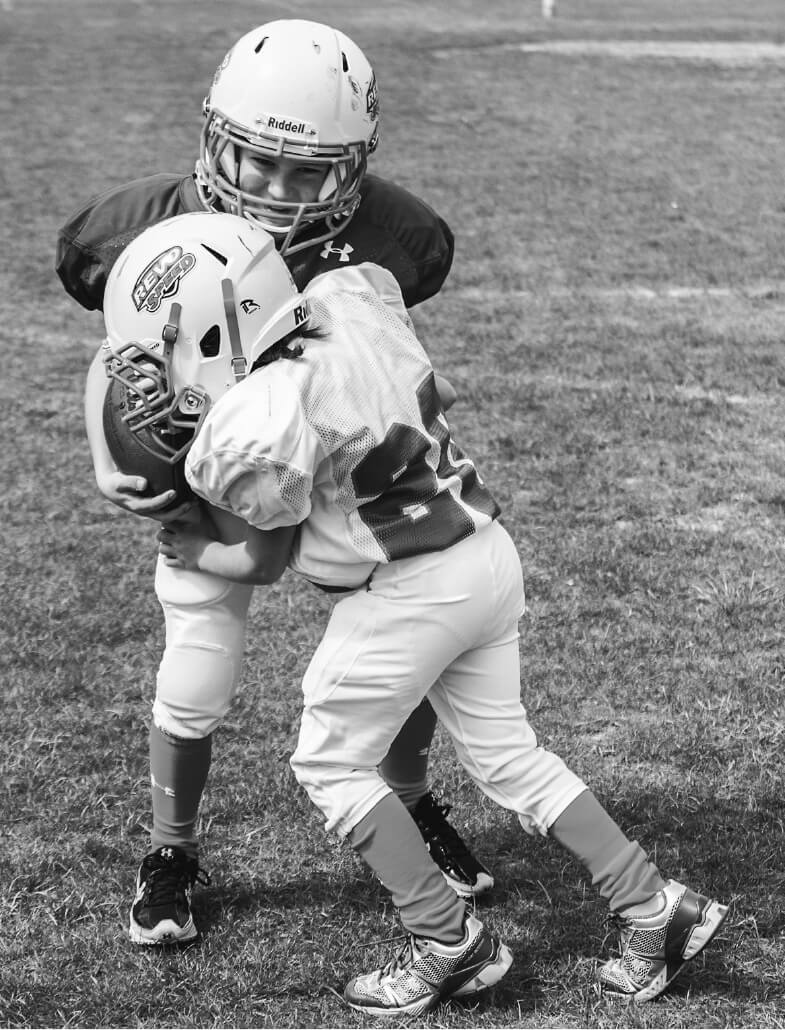Keeping the head out of tackling
This is an excerpt from Coaching Youth Football 6th Edition by Joe Galat.
The importance of keeping your head out of tackling has been proven. AYF's standard of shoulder tackling accomplishes a "Head Out" policy. If you want to have a good defensive team, you must teach your defensive players how to tackle. As the players grow and progress in their learning of the game, you must be sure to teach them the proper shoulder tackling techniques. When first introducing your players to tackling, have them start at half speed until they master the correct technique and feel comfortable with the contact associated with making a tackle. AYF has adopted a standard of keeping a maximum of three steps between players while teaching tackling. This allows for the different age groups to perform at a standard distance that increases as the players grow.
Tacklers should always be in the proper hitting position with their shoulders up, back straight, knees bent, and feet shoulder-width apart. They should also focus on a target or point of contact when making the tackle. While your position and the ballcarrier's position varies, there are generally three targets (points of contact). The three most common are the near pec, the near number area (just slightly above the runner's belt buckle), and the near thigh. If tacklers always focus on a point of contact target, their opponents will not be able to fake them out with a fancy shoulder move, head fake, or spin maneuver.
All tackles should be made with the shoulder pad and never with the helmet. Tackling with the helmet will not only cost your team a penalty, but can also cause serious injury. You must stress to your players that they should always keep their shoulders up and eyes open and that they should position their body so that they tackle with one shoulder pad or the other - and never with their head.
The three basic tackles that your players will use are the front-on tackle, the angle tackle, and the open-field tackle. Following are coaching points for each type.
Front-On, Near Pec Tackle
Defensive players use the front-on tackle when they line up straight across from the offensive runner coming toward them. Tacklers should first make sure that they are in a good hitting position and are ready to make the tackle.
Tacklers must maintain a wide, balanced stance while keeping the feet moving with choppy steps. The back is arched, and the knees are slightly bent. The head and arms should extend in front of the body, and the shoulders should be up. A front-on tackle means that the ball carrier is coming straight toward the tackler - it does not mean that the tackler leads with the head!
When executing the front-on tackle, tacklers explode off the foot on the same side as the shoulder that they will make the tackle with. They drive their shoulder into the runner's near pec as they thrust their hips through (see figure 9.4). With their arms, they wrap and clamp the ballcarrier as they hit with an uplifting uncoil of the legs and drive the ballcarrier backward and off his feet. Tacklers should remain under control so that they don't overrun the ballcarrier or dive and miss the tackle.

If players are missing tackles, make sure that they have widened their feet and shortened their stride and that they are bending their knees and not leaning forward at the waist. For additional practice of front-on tackling, see the drill at the end of chapter 10.
Angle Tackle
The angle tackle is necessary when the ballcarrier runs a wide play or gets close to the sideline. Tacklers must first make sure that they are in a good hitting position, and they must maintain a good balanced stance when preparing for this tackle.
When executing the angle tackle, tacklers must drive the shoulder in front of the ballcarrier's near number, across the line of his run, and upward on the runner at about waist level (see figure 9.5). When players are making an angle tackle with the ballcarrier breaking to their right, for example, they use the left shoulder pad to make the tackle, and they explode off the left foot. The back should be arched to lift and drive through the ballcarrier. With the arms, tacklers should grasp the runner behind the legs and lift him off the ground, keeping their feet moving with short, choppy steps as they finish the tackle, which could be a clamp and roll. Tacklers should remain under control and ready to move in any direction. For additional practice of angle tackling, see the drill at the end of chapter 10.

COACHING TIP If players have trouble getting their shoulder in front of the ballcarrier, check to see that they are taking off with the correct foot. Players should use the shoulder pad and foot on the same side when making the tackle. By cutting off the angle, the defender has gained the leverage upfield.
Open-Field Tackle
After the runner has cleared the line of scrimmage or when a receiver has caught the football and has just one player to beat, defensive players must make an open-field tackle. Tacklers should learn that the most important thing to do in the open field is to get hold of the opponent and pull him to the ground (see figure 9.6). In the stance, tacklers must remain under control with their legs bent, shoulders up, and back straight; they must be prepared to move in any direction.

When executing the open-field tackle, tacklers should remember that their number one priority is to grasp the runner. They should use the sideline to their advantage, penning in or getting an angle on the runner. Once a tackler has a hold on the runner, help should soon arrive. But, if possible, the tackler should try to drive the ballcarrier out of bounds or pull him to the turf. Tacklers shouldn't worry about driving through the player or delivering a hard blow; their sole responsibility is to get hold of the player and prevent the score.
Players who must tackle a ballcarrier in the open field often lunge at and miss the ballcarrier. Remind them to be patient and to make certain where the ballcarrier is going. Then they should commit by opening up and stepping with the foot on the side of the direction that the ballcarrier is moving.
More Excerpts From Coaching Youth Football 6th EditionSHOP

Get the latest insights with regular newsletters, plus periodic product information and special insider offers.
JOIN NOW


